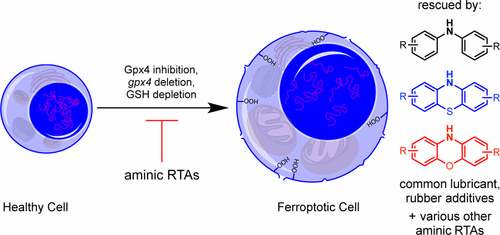当前位置:
X-MOL 学术
›
ACS Chem. Biol.
›
论文详情
Our official English website, www.x-mol.net, welcomes your
feedback! (Note: you will need to create a separate account there.)
The Potency of Diarylamine Radical-Trapping Antioxidants as Inhibitors of Ferroptosis Underscores the Role of Autoxidation in the Mechanism of Cell Death
ACS Chemical Biology ( IF 3.5 ) Pub Date : 2017-09-18 00:00:00 , DOI: 10.1021/acschembio.7b00730 Ron Shah 1 , Kaitlyn Margison 1 , Derek A. Pratt 1
ACS Chemical Biology ( IF 3.5 ) Pub Date : 2017-09-18 00:00:00 , DOI: 10.1021/acschembio.7b00730 Ron Shah 1 , Kaitlyn Margison 1 , Derek A. Pratt 1
Affiliation

|
Two aromatic amines (ferrostatin-1 and liproxstatin-1) were recently identified from high-throughput screening efforts to uncover potent inhibitors of ferroptosis, the necrotic-like cell death induced by inhibition of glutathione peroxidase 4 (GPX4), deletion of the corresponding gpx4 gene, or starvation of GPX4 of its reducing cosubstrate, glutathione (GSH). We have since demonstrated that these two aromatic amines are highly effective radical-trapping antioxidants (RTAs) in lipid bilayers, suggesting that they subvert ferroptosis by inhibiting lipid peroxidation (autoxidation) and, thus, that this process drives the execution of ferroptosis. Herein, we show that diarylamine RTAs used to protect petroleum-derived products from autoxidation can be potent inhibitors of ferroptosis. The diarylamines investigated include representative examples of additives to engine oils, greases and rubber (4,4′-dialkyldiphenylamines), core structures of dyes and pharmaceuticals (phenoxazines and phenothiazines), and aza-analogues of these three classes of compounds that we have recently shown can be modified to achieve much greater reactivity. We find that regardless of how ferroptosis is induced (GPX4 inhibition, gpx4 deletion or GSH depletion), compounds which possess good RTA activity in organic solution (kinh > 105 M–1 s–1) and lipid bilayers (kinh > 104 M–1 s–1) are generally potent inhibitors of ferroptosis (in mouse embryonic fibroblasts). Likewise, structural analogs that do not possess RTA activity are devoid of antiferroptotic activity. These results further support the argument that lipid peroxidation (autoxidation) plays a major role in the mechanism of cell death induced by either GPX4 inhibition, gpx4 deletion, or GSH depletion. Moreover, it offers clear direction that ongoing medicinal chemistry efforts on liproxstatin and ferrostatin derivatives, which have been proposed as lead compounds for the treatment and/or prevention of ischemia/reperfusion injury, renal failure, and neurodegeneration, can be widened to include other aminic RTAs. To aid in these efforts, some relevant structure–reactivity relationships are discussed.
中文翻译:

二芳基胺自由基捕获抗氧化剂作为肥大病的抑制剂的效力强调了自氧化在细胞死亡机制中的作用。
最近,从高通量筛选工作中发现了两种芳香胺(ferrostatin-1和liproxstatin-1),以发现有效的ferroptosis抑制剂,通过抑制谷胱甘肽过氧化物酶4(GPX4)诱导的坏死样细胞死亡,缺失相应的gpx4基因,或其还原性共底物谷胱甘肽(GSH)的GPX4饥饿。此后,我们证明了这两种芳香胺是脂质双层中的高效自由基捕获抗氧化剂(RTA),表明它们通过抑制脂质过氧化(自氧化)而破坏了肥大症,因此,该过程推动了肥大症的执行。在这里,我们表明,用于保护石油衍生产品免受自氧化作用的二芳基胺类RTAs可能是肥大症的有效抑制剂。被研究的二芳基胺包括代表性的机油,油脂和橡胶添加剂(4,4'-二烷基二苯胺),染料和药物的核心结构(吩恶嗪和吩噻嗪),以及我们最近拥有的这三类化合物的氮杂类似物可以对其进行修饰,以实现更高的反应性。gpx4缺失或GSH耗竭),在有机溶液中(k inh > 10 5 M –1 s –1)和脂质双层(k inh > 10 4 M –1 s –1)具有良好RTA活性的化合物通常是强效抑制剂Ferroptosis(在小鼠胚胎成纤维细胞中)。同样,不具有RTA活性的结构类似物也没有抗铁蛋白活性。这些结果进一步支持了以下观点:脂质过氧化(自氧化)在由GPX4抑制gpx4诱导的细胞死亡机制中起主要作用。缺失或GSH耗竭。此外,它提供了明确的方向,可以扩大对已被提议作为治疗和/或预防缺血/再灌注损伤,肾功能衰竭和神经退行性疾病的先导化合物的立普他汀和铁他汀衍生物的药物化学研究工作,以包括其他胺类药物。区域贸易协定。为了帮助这些工作,讨论了一些相关的结构-反应关系。
更新日期:2017-09-18
中文翻译:

二芳基胺自由基捕获抗氧化剂作为肥大病的抑制剂的效力强调了自氧化在细胞死亡机制中的作用。
最近,从高通量筛选工作中发现了两种芳香胺(ferrostatin-1和liproxstatin-1),以发现有效的ferroptosis抑制剂,通过抑制谷胱甘肽过氧化物酶4(GPX4)诱导的坏死样细胞死亡,缺失相应的gpx4基因,或其还原性共底物谷胱甘肽(GSH)的GPX4饥饿。此后,我们证明了这两种芳香胺是脂质双层中的高效自由基捕获抗氧化剂(RTA),表明它们通过抑制脂质过氧化(自氧化)而破坏了肥大症,因此,该过程推动了肥大症的执行。在这里,我们表明,用于保护石油衍生产品免受自氧化作用的二芳基胺类RTAs可能是肥大症的有效抑制剂。被研究的二芳基胺包括代表性的机油,油脂和橡胶添加剂(4,4'-二烷基二苯胺),染料和药物的核心结构(吩恶嗪和吩噻嗪),以及我们最近拥有的这三类化合物的氮杂类似物可以对其进行修饰,以实现更高的反应性。gpx4缺失或GSH耗竭),在有机溶液中(k inh > 10 5 M –1 s –1)和脂质双层(k inh > 10 4 M –1 s –1)具有良好RTA活性的化合物通常是强效抑制剂Ferroptosis(在小鼠胚胎成纤维细胞中)。同样,不具有RTA活性的结构类似物也没有抗铁蛋白活性。这些结果进一步支持了以下观点:脂质过氧化(自氧化)在由GPX4抑制gpx4诱导的细胞死亡机制中起主要作用。缺失或GSH耗竭。此外,它提供了明确的方向,可以扩大对已被提议作为治疗和/或预防缺血/再灌注损伤,肾功能衰竭和神经退行性疾病的先导化合物的立普他汀和铁他汀衍生物的药物化学研究工作,以包括其他胺类药物。区域贸易协定。为了帮助这些工作,讨论了一些相关的结构-反应关系。









































 京公网安备 11010802027423号
京公网安备 11010802027423号